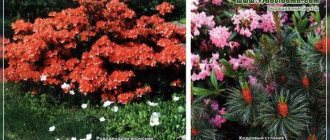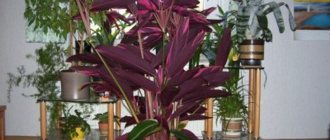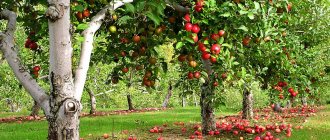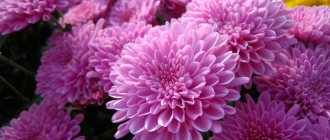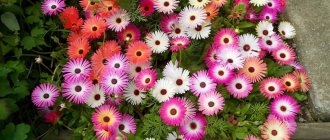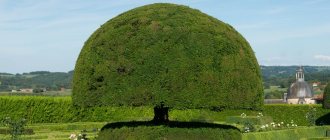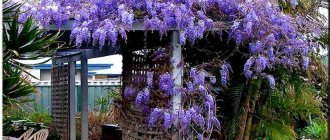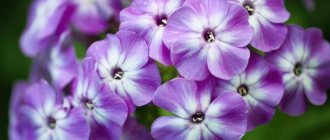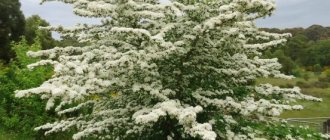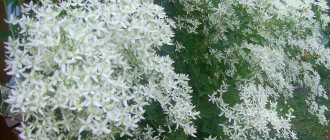Description of rhododendron: varieties and varieties
The genus of rhododendrons is quite extensive - more than 1,000 species, which include diverse varieties of this wonderful plant. The natural distribution area of rhododendrons is limited to eastern countries: China, Japan, Korea, the Himalayas; some varieties of the plant are found in the Caucasus, North America, northern Africa and Australia. In European territory, two varieties of rhododendron grow in the mountainous regions of Germany.
Rhododendron is a magnificent plant with a long flowering period.
The culture belongs to flowering deciduous or evergreen shrubs of the heather family. The branches of the plant may have smooth bark or pubescence. The leathery, dark green, small, ovoid leaves are sometimes pubescent. The flowers are bell-shaped, funnel-shaped, simple and double. The color of the petals varies depending on the variety: white, pink, lilac, red, purple. Modern varieties of rhododendron are yellow and orange in color. Numerous small seeds ripen in capsules.
Rhododendrons, the cultivation of which is most acceptable in Russia, are limited to 26 species belonging to three groups of plants.
- Evergreens are tall shrubs that do not shed their dark, leathery foliage even in winter. Large flowers are painted in different colors and tones. Growing evergreen rhododendrons in open ground requires compliance with a number of necessary rules: plants are located in places with diffuse shade; the soil for them should include a large amount of peat.
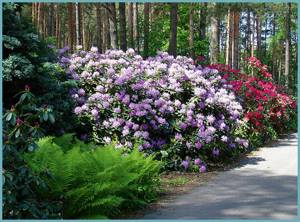
Rhododendron evergreen
Tip: It is important to choose the right location for evergreen rhododendron species, especially when designing areas in landscape design. These can be all types of conifers, heather, ferns grown in open ground.
- Intermediate (semi-evergreen) - low shrubs that winter well under a layer of snow. The plant is characterized by a compact shape and a huge number of flowers during the flowering period. In winter, the main part of the leathery leaves falls off, leaving only a whorl of leaves at the ends of the branches, from the center of which new foliage grows.
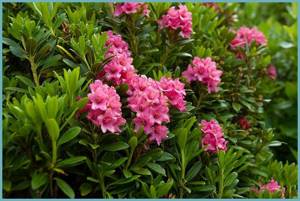
Semi-evergreen rhododendron
- Deciduous - rhododendrons of this group are most adapted to the conditions of the Russian climate. Growing these plants is not difficult, and the plants themselves do not require special adaptation in winter. Flowering in spring, repeated in autumn.
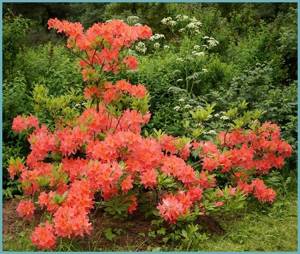
Deciduous rhododendron, variety "Fireworks"
Is it possible to grow azaleas at home and which varieties are best on the site?
You can plant shrubs both in open ground and in separate pots at home . It is important to choose the right variety. Azalea is a beautiful flower, but also very demanding in terms of soil, lighting and watering. Therefore, to grow a beautiful flowering bush at home, you will have to make a lot of effort.
Although there are many hybrids available today, they all originate from two main varieties:
- Indian azalea or Sims' azalea.
- Japanese azaleas with smaller but abundant blooms.
Traditionally, Indian azalea is grown at home, while Japanese shrubs are more suitable for planting in open ground.
When planting azaleas outdoors, pay close attention to choosing the right location. The flowering of the bush will depend on this.
Depending on the flowering time, varieties are divided into:
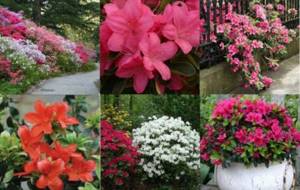
- early flowering (from December to January);
- mid-flowering (from February to March);
- late flowering (from March to April).
Popular varieties for home use:
- with white flowering - Elizabeth, Snowflake;
- with red flowers - Ilona, Florida;
- with raspberry buds - Cosmos, Orange Bowen.
Common varieties for planting in open ground:
- with white flowers - Adonis, Kermesina Alba;
- red buds - Toreador, Fridoline;
- crimson shade - Kermensina Rosa, Raimund.
You can learn how to grow azaleas on a trunk here, and read about the types of azaleas and their healing properties here.
Planting a plant
Rhododendron: planting and caring for plants in compliance with agrotechnical rules - plant replanting is allowed in spring and autumn. In autumn - in any of three months, in spring - in warm, settled weather, when the soil is no longer frozen (usually April or May).
The choice of place for planting a plant must be done with special care. Rhododendron plantings should be protected from the prevailing wind and direct sunlight. It is important that the shrub is accessible for viewing, then the decorative appearance of the plant during the flowering period will decorate the area and please the eye.
Tip: before planting a plant from a container into open ground, it should be thoroughly saturated with water.
The planting hole for rhododendron bushes is prepared based on the actual size of the root system, and should be 2 times larger in volume. Natural soil should be completely removed. To plant a plant, you need to prepare a special soil consisting of equal parts of heather soil; peat; garden soil or leaf humus; rotted manure; needles (pine).
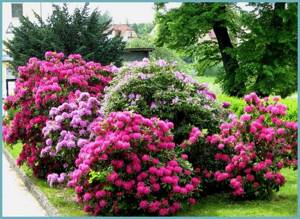
It is very important to plant the plant correctly, then it will quickly take root.
The prepared hole is filled with the mixture, and a place is prepared in it for planting a rhododendron bush, which must be placed strictly vertically. The soil around the root system of the plant must be compressed tightly; the formation of voids and “pockets” in the planting soil is not allowed. If the groundwater level is high, provision should be made for laying a special drainage layer at the bottom of the pit. The top layer of soil after planting should be mulched with peat chips.
Rhododendron: proper watering
Watering the planted plant is carried out at the time of planting - abundantly, sufficient to moisten the soil to a depth of 20-30 cm. Subsequent watering of the rhododendron should be done with soft, acidified water, completely moistening the soil.
Tip: When planting a plant with buds, it is necessary to remove most of them.
Caring for rhododendron in open ground after planting
Caring for rhododendron in the garden is in many ways no different from caring for other ornamental shrubs. The plant requires:
- soil moisture:
- regular, but very careful, so as not to damage the root system, removal of weeds;
- the same careful loosening of the tree trunk circle;
- soil fertilization;
- help with pest attacks.
During the formation of buds and flowering, it is vital for rhododendrons to regularly receive enough moisture. If a plant is in drought conditions, it not only blooms less well this year, but is also unprepared for the next season. The optimal soil acidity for planting rhododendron in open ground in the Moscow region or another region is 4.5–5 units. It is useful to add rotted needles from the forest floor or undeoxidized peat to the irrigation water for this ornamental crop.
You can determine the moment when a rhododendron needs watering by paying attention to the leaves. If they have lost their tone and gloss, there is no need to hesitate! Abundant watering and irrigation of the crown will return the plant to its former beauty.
Rhododendrons are fertilized from early spring until the end of flowering, which occurs in the second half of summer. It is also worth feeding the bushes before flowering, and fertilizers must be applied to the soil that is damp after watering.
As fertilizing, it is useful to use products with an acidic reaction, as well as organic matter, including:
- manure;
- compost with the addition of rotted forest litter;
- horn-bone meal.
Rhododendrons almost do not need formative pruning; sanitary pruning of old, frost-damaged or dried out shoots is carried out in early spring, before the juices begin to flow.
In the summer, when flowering is in progress, it is important to remove faded inflorescences in order to save the shrub’s energy for laying flower buds for next year.
When planting and caring for rhododendron in the open ground, you need to take into account that the crop is heat-loving and in winter, without shelter, can be seriously damaged. Frost protection is prepared in advance. Already by October in the north and by November in the middle zone, the root zone is sprinkled with peat, and then, before the attack, the crown is tied up and covered with spruce branches and burlap. It will be possible to remove the shelter only in early spring, preferably on a cloudy day, to avoid sunburn and cracking of the bark.
Plant care
The transplanted plant requires attention and careful care. In addition to regular, abundant watering, rhododendron requires foliar spraying, especially when planting in late spring. The soil needs to be mulched to retain sufficient moisture. When mulching, you should choose options that increase the acidity of the soil.
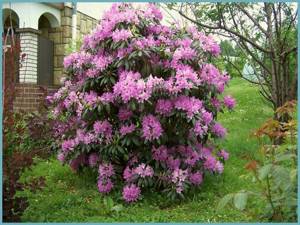
The plant requires regular watering
The root system of rhododendrons consists of delicate, thin hairs, similar to matted hair, so loosening the soil, especially deep, should be excluded from flower care measures. Weeds that grow near the plant must be removed periodically.
The appearance of the plant will immediately indicate a lack or excess of water - the leaves of the rhododendron will begin to turn yellow and fall off. Watering must be carried out in sufficient quantities, but without overflowing; this is one of the main rules for caring for crops.
To ensure proper care of rhododendron, it is important to carry out timely pruning of overgrown bushes. To prevent infection of the plant, the cut areas are covered with paint or garden varnish.
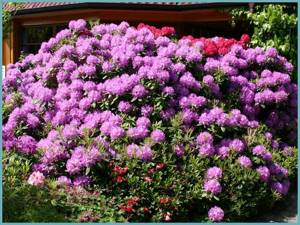
Bushes need to be trimmed periodically
Compliance with simple plant care requirements will allow you to grow a wonderful flowering bush.
Rules of care

Despite the capriciousness of rhododendrons, caring for them is not particularly difficult. First of all, they need regular spraying. It is better to do this before flowering and only in the morning or evening, otherwise the plant may get sunburn.
It is not recommended to loosen the soil around the bush, as you can easily damage its root system located in the surface layer of soil. It is enough to limit yourself to regular removal of weeds that grow next to the bush.
Watering
Rhododendron needs the most abundant watering in the first year after planting, as this promotes rapid rooting of the plant. It will also be necessary to water the shrub during periods of summer drought. For irrigation use soft acidified water.
Usually, rhododendron itself signals a lack of water - the leaves lose turgor and become dull. If they turn yellow and begin to fall off, this may indicate an excess of water in the soil, which makes it difficult for oxygen to reach the roots. In this case, the soil is carefully loosened and allowed to dry.

Fertilizer
In the first year after planting, seedlings are regularly but little by little fed with liquid fertilizers. Signs of malnutrition include:
- lightening of leaves, their falling;
- dull foliage;
- lack of buds and slow growth of young shoots.
It is best to use rotted manure for feeding; superphosphate is a good mineral fertilizer. Before applying fertilizers, water the soil abundantly to protect the roots from burns.
Trimming
Despite the fact that rhododendrons naturally have a regular crown shape, from time to time they need to be pruned to remove excess branches. As a rule, branches are cut to a thickness of 2-4 cm. After pruning, it is imperative to treat the cut areas with oil paint or garden varnish.
Wintering
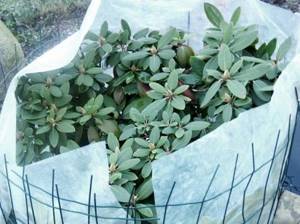
Shelter for the winter
Rhododendron bushes must be covered for the winter; this will protect them from severe frosts and ensure abundant flowering in the spring.
This procedure is carried out in mid-November. For shelter, you can use roofing felt or build special frame structures or foam houses that will protect the plants from gusts of wind and snow. The shelter is removed only after the air temperature reaches +10 degrees, around April. It is better to do this on a cloudy day so that the rhododendron has time to adapt to sunlight after a long winter.
Fertilizer and feeding of rhododendron
In the first year, transplanted plants already require careful fertilizer, which is applied in a highly diluted form, in small portions. The plant itself will signal the need to apply fertilizer: it will stop growing, shed its foliage or the leaves will change color, and the formation of flower buds will stop.
Organic fertilizer for feeding rhododendron bushes is semi-decomposed manure that needs to be infused in water. Feeding is carried out with an aqueous solution of manure. To increase the formation of flower buds, as well as extend the flowering period, granular superphosphate, or double superphosphate, is used, which is scattered on the moist soil under the plants. Feeding the plant with microelements is also beneficial - fertilizers are applied in the form of watering or spraying the green mass of the bush. It is necessary to intensively fertilize the bushes until the end of August.
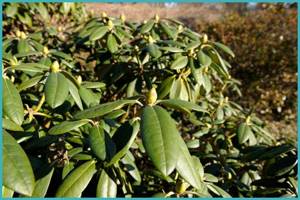
Rhododendron before flowering
Rhododendron propagation
Growing rhododendron involves propagating the plant by layering and seeds, dividing the bush, grafting, and cuttings.
Seed propagation is an excellent way to obtain plants with improved traits. Sowing takes place from the end of December to the end of March. The second period suitable for seed propagation of rhododendrons is the end of November.
Sowing of seeds is carried out in shallow bowls or boxes filled with a nutrient mixture of peat, sand, coniferous and turf soil, taken in equal proportions. The seeds are pre-soaked for a day. Sowing is done on the top layer of soil, without planting deep into the ground. The crops are moistened by spraying. It is necessary to provide the seedlings with 12-hour illumination with fluorescent lamps. The timing of seed germination depends on the variety. The first flowering of seedlings is possible after 3-4 years.
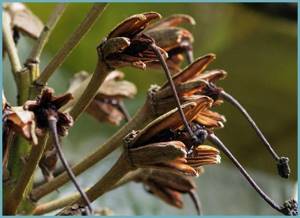
Rhododendron seeds
This method has its advantages, but when propagating rhododendrons from seeds, it takes up to 5-6 years to obtain full-fledged plants.
New plants can be obtained faster using vegetative methods of crop propagation: cuttings, dividing the bush, rooting layering.
Step-by-step instructions for the procedure at home
Preparing the pot and other equipment
Before planting your azalea, prepare everything you need:
- capacity;
- soil;
- drainage;
- small spatula;
- transparent film to create a greenhouse effect (if necessary).
All items must be pre-sterilized to protect the plant from disease.
Read about pests and diseases of azaleas here.
Since the root system of the shrub is superficial, the best option would be to choose a shallow but wide ceramic pot. Be sure to use drainage approximately 20 cm high.
Soil preparation
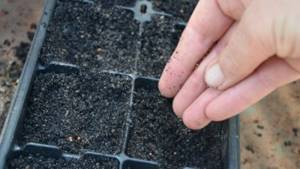
The plant needs acidic soil with a pH of 4-5, loose, with good water permeability, rich in humus.
It is best to purchase ready-made soil “for heathers” in specialized garden stores. It contains all the components necessary for the bush.
If necessary, you can make the soil yourself . To do this you need to take:
- 1 part moss;
- 1 part sand;
- 1 part peat and 2 parts rotted pine needles.
Landing method
Propagation by seedlings
Propagating azaleas by seedlings is a relatively simple method. To do this, you need to buy a young plant, no older than a year.
Propagation by seedlings should be done only after the bush has flowered, that is, in the spring.
- The azalea pot needs to be immersed in water for 20 minutes to ensure the soil and roots are properly moistened.
- After removing from the water, set aside for a while, allowing excess water to drain.
- Using a sharp, pre-disinfected knife, cut into two or three parts (depending on size). The roots of azaleas are fragile, they must be handled carefully, trying not to damage them, it is best to untangle them with your hands.
- Without shaking the soil from the roots, we plant it in a separate prepared container with expanded clay.
Sowing seeds
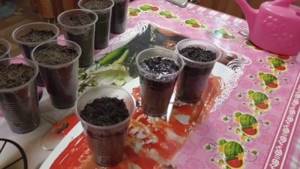
Propagating shrubs with seeds is a labor-intensive method; it is mainly used by professional gardeners to produce hybrids.
- First, prepare the soil with the required acidity; it is advisable to further disinfect it by calcination or a weak solution of potassium permanganate.
- Pour drainage into a container (here you can choose any for convenience - cups, containers, planting pots). Then the soil layer, leaving 1-2 cm to the edge of the container. There is no need to compact the soil.
- Place the seeds on top of the soil, without covering them with soil, so that the distance between them is at least 1.5 cm.
- Moisten with warm, settled water from a spray bottle.
- We create a greenhouse effect by placing glass on top or covering it with a transparent film.
Make sure that mold does not appear on the soil; to do this, periodically remove the glass or film.
Seed germination can take a long period, up to 3-4 weeks . After the first leaves have appeared, the plants are planted and hardened. When the height of the sprout reaches 12 cm, it can be transplanted into a separate pot.
We invite you to watch a video about the features of planting rhododendron seeds:
How to root cuttings correctly?
The best way to propagate azaleas is by cuttings. It is also carried out only after flowering, before summer, then the rooted plant can be planted separately in the fall.
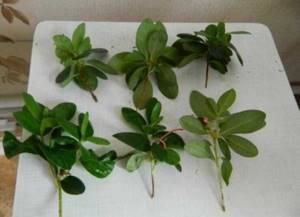
- cut the top cuttings up to 10 cm long;
- remove the top bud and undeveloped leaves, leaving 2-3 healthy ones;
- Use pruning shears to make the bottom cut at an angle of 45 degrees;
- place the cuttings in separate containers filled with high-moor peat to a depth of 2-3 cm;
- water and spray with warm, settled water;
- cover with glass, film, or place in a greenhouse.
It is important to periodically ventilate the cuttings . The formation of roots takes 1.5-2 months. After shoots appear on the cuttings, they can be transplanted into separate pots. To form the correct crown, you must immediately pinch the top.
Children
To propagate garden azaleas, you can use seedlings from rooted cuttings.
This procedure is quite lengthy, you need to start it in the spring, roots may appear by the fall, but it is best to separate the “baby” for independent planting next spring, that is, in a year.
- Select the lower shoot and make a small cut in it into which to insert a match.
- Gently bend it to the ground, securing it in place with a wire pin.
- Raise the upper part of the layer to a vertical position, attaching it to a peg.
- Cover the cut area with soil and water regularly.
Read more about azalea propagation here.
Diseases and pests
Compliance with the requirements for agricultural technology of rhododendrons guarantees excellent growth and development of plants. However, repeated waterlogging or overdrying of the soil, alkaline soil reaction, and sunburn of leaves can provoke a surge in crop diseases.
Plants can be damaged by spotting, rust and chlorosis. Disease control measures - improving plant conditions, using special means to combat diseases. Often diseases of rhododendrons are caused by pathogenic fungi: gray rot, fusarium, late blight.
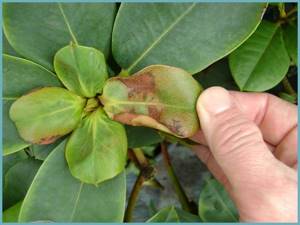
Spot is a fungal disease of rhododendron
Pests that damage rhododendrons: slugs and snails that eat young leaves and buds. These pests are collected manually. In addition, the plant is harmed by: bugs (rhododendron), spider mites, mealybugs, weevils, scale insects, and rhododendron fly. Getting rid of pests is not difficult when using systemic insecticides.
Rhododendron: combination with other plants
Planting plants in combination with conifers and a group of heathers has a positive effect on the development of rhododendrons. In this case, you should remember the height of the rhododendron bush. Low cultivars should be located away from the dense shade of mature trees, but avoiding direct rays of the sun.
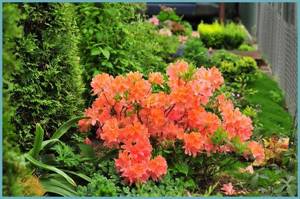
Blooming rhododendron perfectly shades conifers
An excellent combination is observed when shade-loving ferns and hostas are located next to rhododendrons.
Rhododendron in landscape design
In landscape design, rhododendron is an indispensable attribute for planting in partial shade. The great advantages of the plant are its long-lasting and very decorative flowering. Rhododendrons are widely used in the design of heather gardens, as an addition to the planting of pine groves. The plant looks great in mono plantings.
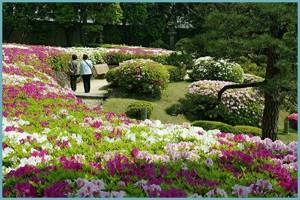
Rhododendron in landscape design
Low-growing varieties of rhododendrons are planted near alpine hills, in mixborders and in decorative flower beds.
Description of rhododendron
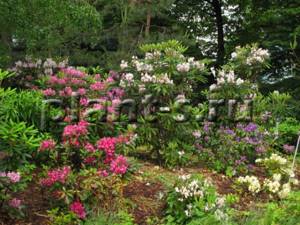
Rhododendron garden
Rhododendron is a separate genus of flowering shrubs, although tree-like forms are also found, belonging to the Heather family. Its leaves can be evergreen, overwintering or deciduous. The first ones remain on the bush for up to 3-6 years, after which they are replaced by new ones, the wintering ones live only 1 year, and the falling ones are replaced every year, falling off in the fall, like other plants. The shape of the leaves can be different: ellipsoidal, round, spear-shaped. Corymbose inflorescences consist of large flowers of different shapes and colors.
The homeland of rhododendron is the Far East, mountain forests of Japan and China.
Rhododendron can be classified as a medicinal plant, as its leaves are rich in ascorbic acid. It is used to treat heart disease, rheumatism, epilepsy, colds, and chronic colitis. An infusion of rhododendron leaves removes excess fluid from the body, normalizes heartbeat, and reduces shortness of breath. However, the leaves also contain toxic substances, so you need to be very careful when treating with this plant.
In landscape design, rhododendron is used to decorate gardens in any style. It looks great both in single plantings and in large compositions.
These shrubs go well with coniferous trees or bushes - ferns, junipers, larches.
Often, low-growing species of rhododendron are used to create alpine hills and rocky gardens, combining them with heathers, mountain pine or gentian.
Common types and varieties
The garden shrub rhododendron has many species and even more varietal varieties. Each species has its own biological characteristics, which significantly affects its requirements for growing conditions. Frost resistance, requirements for lighting, soil moisture, air, soil composition, etc. may vary from species to species.
For example, rhododendron with large leaves reacts more strongly than others to the presence of cold wind or draft, while needing high air humidity. Therefore, it is recommended to plant such species in a place protected from drafts.
The most popular types include the following:
- Daurian;
- Japanese;
- Canadian;
- Schlipebach.
Rhododendron Daurian
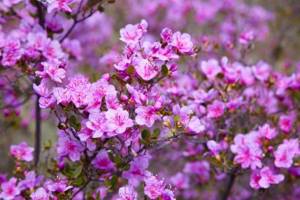
R. daurskii
Belongs to the evergreen variety. This is a low (about 2-4 m) branched shrub, with light or dark gray bark, rusty-brown pubescent shoots. The color of the leaves varies with the seasons from light green to brown. In winter, a few leaves may fall off, but by spring new ones appear. Flowering occurs before the young leaves appear and lasts approximately 3 weeks. Daurian rhododendron blooms with large (up to 4 cm in diameter) funnel-shaped flowers of lilac-violet color, collected in inflorescences. Sometimes flowering may begin again by autumn.
This variety includes varieties:
- AprilReign. It blooms early - from about mid-April. Double pink flowers are collected in large inflorescences;
- AprilSnow. A shorter bush that tolerates frosts down to -28 degrees. It also blooms early with large white flowers.
Japanese rhododendron
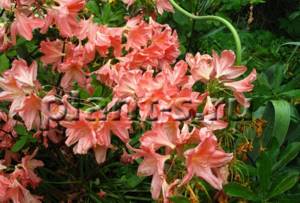
R. japonica
A representative of deciduous shrubs, reaching 1-2 m in height. The plant attracts attention with its bright large flowers, painted in all shades of red and yellow, as well as the change in foliage color from dark green in summer to crimson-yellow in autumn. Flowering can last for several weeks, starting in late spring. This type of rhododendron tolerates winter frosts well, provided that it is properly prepared for wintering.
The most interesting varieties of this species are:
- CreamCrest. An evergreen, winter-hardy shrub that can withstand frosts down to -32 degrees. It blooms in May-June with large creamy-white bells;
- Aureum. Low growing bush with beautiful golden flowers. Frost-resistant, but does not tolerate heat well.
Canadian rhododendron
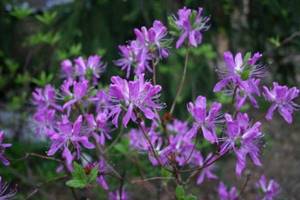
R. canadensis
A low shrub (up to 1 m tall) with large leaves and large pink-purple flowers, collected in small (up to 5 pcs.) inflorescences. One of the most frost-resistant species, therefore suitable for cultivation even in the northern regions of Russia.
Rhododendron Schlippenbach
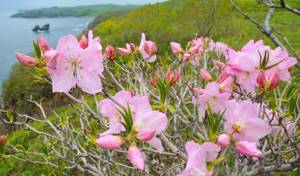
R. Schlippenbach
It belongs to deciduous shrubs, reaching 2 meters, although it can also be a small tree (up to 5 m). The oval leaves are light green in summer, changing to orange and bright purple in autumn. Spectacular bell flowers (up to 10 cm) are collected in large (6-10 pcs.) inflorescences and can be painted in different shades of pink, although white-flowered varieties are also found. Flowering begins simultaneously with the appearance of leaves or even slightly earlier.
Hybrid varieties
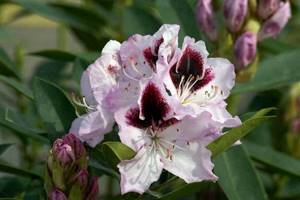
R. hybrid “Sappho”
The most popular varieties of rhododendron for gardens and flower beds in Russia are:
- JohnWalter (profusely flowering bush with bright red flowers);
- PinkPearl (fast-growing shrub with large pink inflorescences);
- Sappho (white-flowering hybrid variety);
- PurpleSplendour (distinguished by a beautiful purple-violet hue of flowers).
